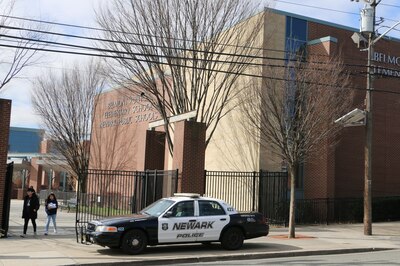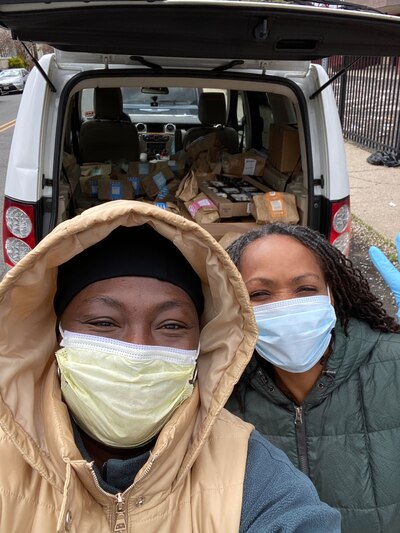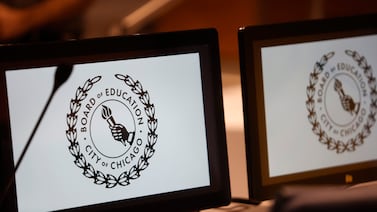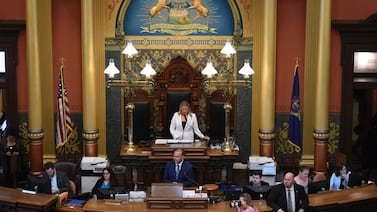In Newark, only a small fraction of the students who rely on schools for breakfast and lunch during normal times are picking up bagged meals during the pandemic, according to district data, which shows the city is serving far fewer take-home meals than other high-poverty districts in New Jersey.
Newark has distributed an average of 4,000 grab-and-go meals per day since the coronavirus forced school buildings to close last month, according to data provided by the district. By contrast, district schools served at least 40,000 federally subsidized meals each day when buildings were open, according to state data reported by Advocates for Children of New Jersey.
With so much unclaimed food, volunteers at some schools have started dropping off meals at families’ homes.
All told, the Newark district, serving 36,000 students, handed out roughly 100,000 bagged meals during the first five weeks of the statewide school closures, officials said.
Some smaller districts, which enroll 30,000 students or fewer, gave out many more meals during the same period. For instance, the Paterson school district served nearly 208,000 grab-and-go meals, Elizabeth gave out 187,000, and Jersey City distributed 138,000, officials said. In those districts, as in Newark, the majority of students qualify as poor.
Newark parents and school employees suggested several possible causes of the low turnout, including families’ fears about venturing out daily for meals in a city hit hard by the virus, especially if they do not live near one of the district’s 16 meal sites.
Observers said the district might boost turnout if it increased advertising, let families pick up several days’ worth of meals at once, or delivered meals to some families — all strategies that other districts have used to ensure children stay fed during the crisis.
“Schools need to continue to play a major role in ensuring that kids have access to food,” said Lisa Pitz, outreach director of the advocacy group Hunger Free New Jersey. “The need has been there, the need is certainly there now, and I think that need is going to continue to grow in the coming weeks and months.”
Under a new state law, districts must continue feeding all students who qualify for free or reduced-price meals — even though the pandemic has forced school buildings shut. The state will incur any costs not reimbursed by the federal government.
Since school buildings closed on March 16, Newark has offered free take-home meals to any city student, including those who attend charter and private schools. Families can visit designated schools in each ward to pick up the bagged meals, which have included sandwiches, fruit cups, cereal, and cookies.

The operation has been safe and efficient, said John Abeigon, president of the Newark Teachers Union, noting that workers wear masks and gloves and families stand a safe distance apart while in line.
“It’s like a McDonald’s drive-through,” said Abegion, who has been visiting meal sites this week. “It takes less than 30 seconds.”
Yet turnout has been surprisingly low at some schools. Central High School, which has nearly 800 students, has served just 40 meals per day on average, Abeigon said. Traffic has been higher at other schools, including Park Elementary School, which has averaged 200 meals per day, he said.
Two school employees, who spoke on the condition of anonymity, said some families have experienced challenges picking up food. One said workers at a meal site turned away a parent whose child did not attend that school, even though district policy allows students to get food at any site. A teacher said another site initially only let students take meals for themselves, even though the policy is to allow students or parents to pick up meals for any family members who are students.
“We were throwing a lot of food away in the beginning,” the teacher said.
Other people offered different theories: some parents appear to be unaware the district is offering grab-and-go meals, others do not live near the distribution sites, and still others are essential workers who cannot make the morning pickup time. Finally, some families might be avoiding the daily food distribution out of fear of the coronavirus, which had killed nearly 300 Newark residents as of Tuesday.
“They’re probably not coming out because of this virus,” said Ruby Morrison, whose grandson attends John F. Kennedy School, where a teacher has been dropping off bagged meals at Morrison’s house so she doesn’t have to stand in line. “It’s important we’re at home so we’re not exposed as much.”
Other districts with more success serving meals during the pandemic have found creative solutions to these problems.
The Elizabeth school district uses letters, emails, text messages, automated phone calls, and social media posts in multiple languages to inform families about the meal distribution, said spokesman Pat Politano. Police officers have also helped deliver meals to families with disabled parents, he said.
Paterson has served more than 17,000 meals per day on average, largely through the help of volunteers — including teachers and even the superintendent, Eileen Shafer. This month, the district began giving out multiple days worth of food that can be stored, including Chef Boyardee canned pasta products, in order to limit the number of times that families and volunteers must leave their homes.
“As time goes on, people have become more concerned about their safety, and I don’t blame them,” Shafer said. “But it’s really important that we continue to provide the meals.”
The Newark school district has not announced any steps to improve its low meal numbers. But spokeswoman Nancy Deering said, “We are continuing to assess our efforts.”
In the meantime, school workers are doing what they can to make sure no child goes hungry.

Volunteers from three schools — Central, George Washington Carver, and Mount Vernon — have set up makeshift pantries at local churches to give out fresh vegetables provided by Table to Table, a nonprofit that distributes donated produce. Some of those volunteers are also delivering food to families who, for whatever reason, cannot pick it up themselves.
“It’s a terrible time,” said LeKeshea Brooks-Wertz, a social worker at Kennedy who has been dropping off packages of vegetables and the district’s bagged meals at several families’ doorsteps. “If I can help someone, let me help them.”
Devna Bose contributed reporting.







